AI and Turnitin are two technologies that can combat plagiarism in education. AI, or artificial intelligence, is a form of intelligent agents, which are systems that can reason, learn, and act autonomously. Turnitin is a plagiarism detection service that helps educators to identify and prevent plagiarism in student work.
AI can be used to improve Turnitin’s plagiarism detection capabilities in several ways. For example, AI can identify new forms of plagiarism. The use of AI to generate articles and other types of writing is widespread for creating an instant approach to article writing. Therefore, determining the originality of the source can be done using a Plagiarism Checker such as Turnitin.
Furthermore, AI can enhance the accuracy of plagiarism detection by identifying similarities between student work and other sources that might be missed by traditional methods. Additionally, AI can provide more context for plagiarism detection by identifying the sources that student work is most similar to, helping educators understand why students may have plagiarized, and providing more effective feedback.

Overall, AI has the potential to significantly enhance Turnitin’s ability to detect and prevent plagiarism in education. By leveraging AI, educators can be more confident that their students are submitting original work and upholding academic integrity.
Examples of how AI is being used to improve Turnitin’s plagiarism detection capabilities include Turnitin’s AI writing detection feature, which can identify text generated by an AI writing tool, and Turnitin’s AI similarity detection feature, which can identify similarities between student work and other sources. Additionally, Turnitin’s AI feedback tool provides educators with more context for plagiarism detection, aiding in understanding students’ behaviour and providing effective feedback.
As AI continues to develop, it is likely to become even more effective at detecting and preventing plagiarism in education, ensuring that students create their own original ideas or work to be evaluated.

About the Author:
MOHAMMAD SHAHIDH MOHAMMAD KHAIDIR
Lecturer, School of Information Technology, SEGi College Penang
Mohammad Shahidh has been teaching at SEGi College Penang since 2010. Before becoming a Lecturer, he worked as an ICT Network Engineer, gaining experience building network projects for UPSI, PKNS, and other companies. Shahidh shares his industry-related experiences with students, particularly in Networking Subjects and Project Management. Teaching various courses from the University of Greenwich, University of Hertfordshire, University of Iowa, University of Troy, University of Sunderland, and SEGi College programmes, Shahidh’s passion for teaching and dedication to guiding students prepare them for the working environment.

